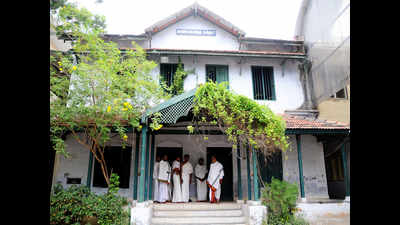- News
- City News
- chennai News
- 111-year-old Madras Sanskrit College goes digital
Trending
This story is from March 7, 2017
111-year-old Madras Sanskrit College goes digital

Madras Sanskrit College, Mylapore
CHENNAI: It's the dawn of a new era at Madras Sanskrit College in Mylapore. The 111-year-old institution is finally going digital in a bid to get on with the times. On Tuesday, courses will go online, classrooms will go global and Sanskrit books will turn 'live'.
The campus will take on a virtual avatar -50,000 palm leaf manuscripts will be digitised and webcasts made possible with Sanskrit scholars around the world.“We want to engage with Sanskrit lovers of all ages and levels of knowledge,“ says trustee Ramesh Mahalingam. “It's what we call a total website for people at any level of Sanskrit, whether beginner or advance.“
The Madras Sanskrit College, started on February 1, 1906, owes its origin to the philanthropy of V Krishnaswami Iyer, a judge in the Madras high court. In 1907, the college was recognized by the director of public instruction and placed in the list of aided institutions with a grant of Rs 1,000.
The Kuppuswamy Sastri Research Institute, on the same campus, is a pioneer in the preservation and study of ancient and rare manuscripts. The college played host to Mahatma Gandhi in 1915 and Rabindranath Tagore in 1922.
One of the first manuscripts digitized was the Gajashastra, a compendium of the veterinary science of the elephant, he adds.“Anyone seeking knowledge on the elephant can make use of this from the net,“ says Mahalingam.The only drawback though is that, at the moment, there are no translations of the texts, and one needs to have a knowledge of Sanskrit to read them. “We have plans to get comic books online with voice-overs as well as translations. We are taking every step to keep the language alive,“ says Mahalingam.
The campus will take on a virtual avatar -50,000 palm leaf manuscripts will be digitised and webcasts made possible with Sanskrit scholars around the world.“We want to engage with Sanskrit lovers of all ages and levels of knowledge,“ says trustee Ramesh Mahalingam. “It's what we call a total website for people at any level of Sanskrit, whether beginner or advance.“
The Madras Sanskrit College, started on February 1, 1906, owes its origin to the philanthropy of V Krishnaswami Iyer, a judge in the Madras high court. In 1907, the college was recognized by the director of public instruction and placed in the list of aided institutions with a grant of Rs 1,000.
The Kuppuswamy Sastri Research Institute, on the same campus, is a pioneer in the preservation and study of ancient and rare manuscripts. The college played host to Mahatma Gandhi in 1915 and Rabindranath Tagore in 1922.
Mahalingam says original Sanskrit manuscripts are being digitised so that they are accessible to anyone seeking information. “There are Sanskrit books on astronomy , ayurveda, medicine and astrology . With these manuscripts online, experts in those fields will have access to information from centuries ago.“
One of the first manuscripts digitized was the Gajashastra, a compendium of the veterinary science of the elephant, he adds.“Anyone seeking knowledge on the elephant can make use of this from the net,“ says Mahalingam.The only drawback though is that, at the moment, there are no translations of the texts, and one needs to have a knowledge of Sanskrit to read them. “We have plans to get comic books online with voice-overs as well as translations. We are taking every step to keep the language alive,“ says Mahalingam.
End of Article
FOLLOW US ON SOCIAL MEDIA










